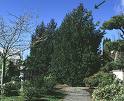Calocedrus Decurrens Tree Information
Images of Calocedrus Decurrens:






Calocedrus Decurrens grows in the following 6 states and provinces:
California, Colorado, Hawaii, Maine, Nevada, OregonInformation about Calocedrus Decurrens:
as well ashe Calocedrus Decurrens is commonly known as the Incense-cedar.
The currently accepted scientific name for incense-cedar is Calocedrus decurrens (Torrey) Florin. There are no infrataxa .Incense-cedar is generally found from the southern slope of Mount Hood, Oregon, southward through the Siskiyou, Klamath, and Warner mountains, Cascade and Coast ranges, and from the Sierra Nevada to the Hanson Laguna and Sierra de San Pedro Martir ranges in Baja, California. Incense-cedar is most common in the Sierra Nevada, occurring individually or in small groups . It is cultivated in Hawaii .On dry, shady sites, incense-cedar is considered climax due in part to its relative tolerance of shade. In the northern Oregon Cascades, however, incense-cedar typically grows as a minor component of stands dominated by western hemlock (Tsuga heterophylla), western redcedar (Thuja plicata), and grand fir (Abies grandis) . Typically, incense-cedar is found in mixed-forest types and rarely in pure stands. Overstory associates found throughout its range include white fir (Abies concolor), ponderosa pine (Pinus ponderosa), Jeffrey pine (P. jeffreyi), sugar pine (P. lambertiana), and California black oak (Quercus kelloggii) . A publication listing incense-cedar as a dominant species in a plant association is: Preliminary plant associations of the southern Oregon Cascade Mountain Province Some of the information provided here is attributed to:Habeck, R. J. 1992. Calocedrus decurrens. In: Fire Effects Information System, [Online]. U.S. Department of Agriculture, Forest Service, Rocky Mountain Research Station, Fire Sciences Laboratory (Producer). , available at the USDA Fire Effects Information System (FEIS) website